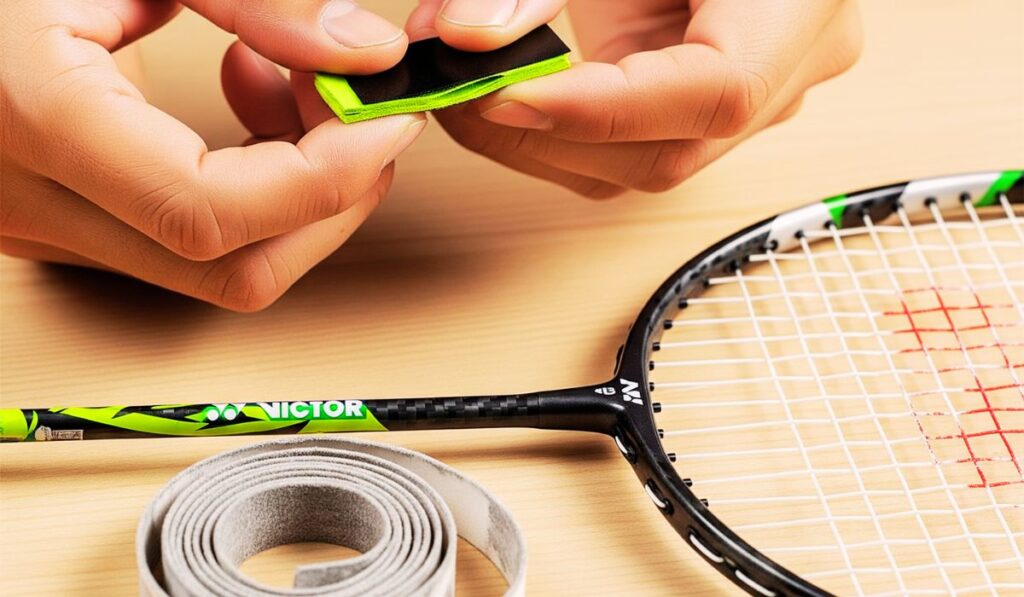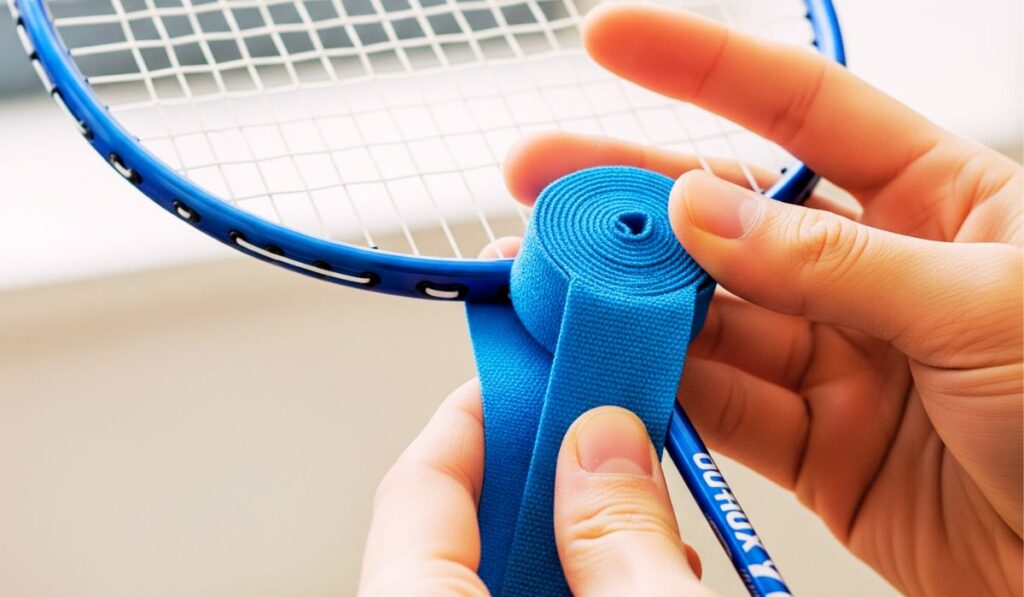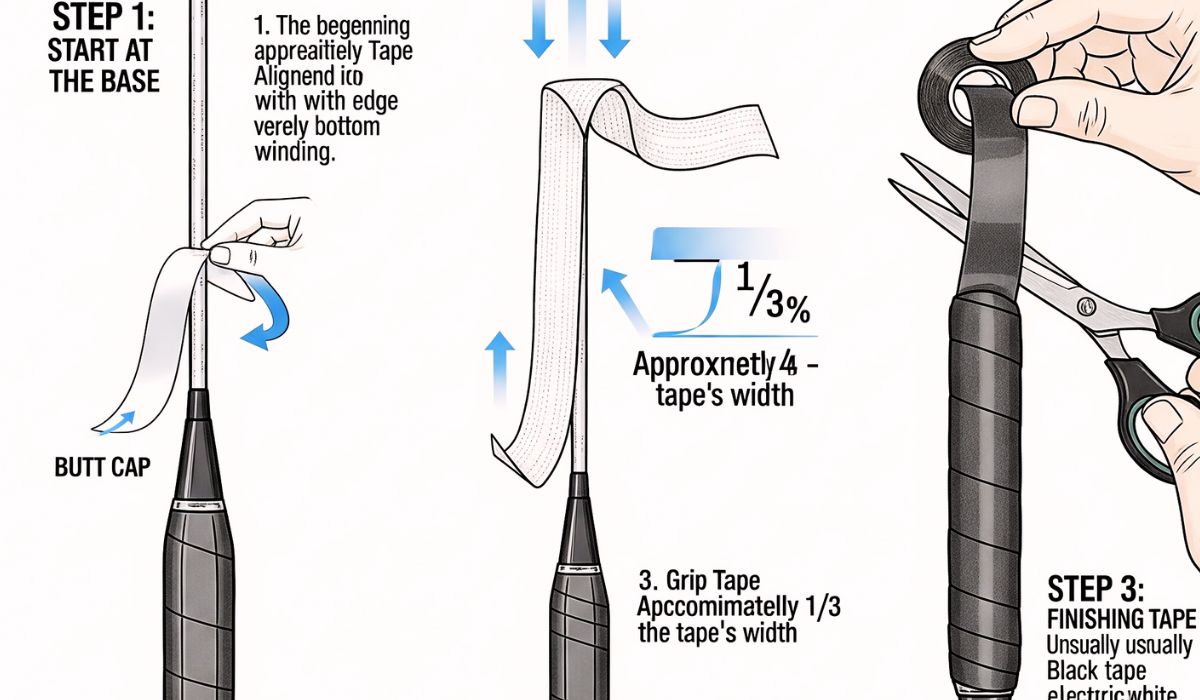Why Most Players Fail at Badminton Grips (And the Game-Changing Method You’ll Love)
There is something intimate about the feel of a badminton racket in your hand. It’s more than just sports equipment — it’s an extension of your arm, a trusted partner that reacts to every flick of your wrist, every whisper of movement. Yet so many players, even those who train hard, treat the grip as an afterthought. That thin layer of material between your palm and the racket’s handle can be the difference between a graceful drop shot and a clumsy miss.
If you have ever felt your racket slipping during a rally or noticed your hand cramping halfway through a game, the problem may not be your swing — it might be the way you’ve gripped the handle. Knowing how to put a grip on a badminton racket properly isn’t just a matter of comfort; it’s a matter of control, confidence, and sometimes even pride.
The Hidden Role of the Grip in Badminton Performance
how to put a grip on a badminton racket isn’t just there to make the handle look neat or feel soft. It has a quiet but powerful influence over every aspect of your play. Think of it as the handshake between you and your racket — too loose, and the connection feels awkward; too tight, and it becomes uncomfortable.
When fitted perfectly, How to put a grip on a badminton racket allows your fingers to settle naturally, cushioning every shock from a smash and absorbing sweat during an intense rally. Without it, the wood beneath can feel cold and unyielding, sending vibrations up your arm with each hit. Over time, that discomfort can erode not only your performance but your enjoyment of the game itself.
Understanding the Types of Badminton Grips
Before you learn how to put a grip on a badminton racket, you need to understand that not all grips are the same. The one you choose depends on your style of play, the climate you play in, and even how your hands naturally sweat.
- Overgrip – Thin, lightweight, and usually wrapped over an existing grip. Perfect for adjusting thickness or adding a fresh, tacky feel without replacing the base grip entirely.
- Replacement Grip – Thicker and more cushioned, designed to replace the original grip entirely. Ideal if the factory grip has worn out or you want a custom feel.
- Towel Grip – Soft and absorbent, loved by players with sweaty hands. However, it needs more frequent replacement to maintain freshness and texture.
Each has its own charm. Overgrips give you subtle precision. Replacement grips offer plush comfort. Towel grips invite a warm, velvety feel that can make every swing feel like a personal signature.
Why Many Players Fail at Gripping Their Racket
Here’s the blunt truth: most players either wrap their grip too loosely, too tightly, or unevenly. This leads to bubbles under the grip, awkward bumps, or a spiral pattern that digs into your skin during play. Some players don’t even notice the damage until their racket starts turning in their hands during a fast rally.
The most common mistakes include:
- Not starting the wrap at the correct angle
- Leaving gaps between layers
- Pulling the grip too hard, stretching it until it loses its cushioning
- Neglecting to secure the end properly, causing the wrap to unravel mid-game
These mistakes aren’t just annoying — they can ruin your rhythm, making you tense your hand unnecessarily and wasting energy you should be putting into your shots.

Step-by-Step: How to Put a Grip on a Badminton Racket
Let’s walk through this as if we were side by side, sitting at a table, the smell of fresh grip tape in the air, and the gentle anticipation of knowing your racket is about to feel brand new.
Step 1 – Prepare the Racket
Remove the old grip if necessary. Run your fingers along the handle to make sure there are no leftover bits of tape or sticky residue. A smooth surface will make the new grip sit more comfortably.
Step 2 – Find the Starting Point
Most players start from the bottom of the handle, where a small flare or “cone” keeps the grip from slipping off during play. Place the tapered end of your new grip here.
Step 3 – Angle and Wrap
Hold the racket firmly in one hand. With the other, begin wrapping the grip at a slight diagonal, overlapping each layer by about one-third of its width. This creates even coverage without gaps.
Step 4 – Adjust Tension
Here’s the secret: do not pull the grip tape as if you were trying to stretch it to its limit. Instead, keep a gentle but steady tension. This keeps the grip soft while ensuring it stays in place.
Step 5 – Finish and Secure
When you reach the top of the handle, cut away any excess grip and secure the end with finishing tape. Smooth it down so there are no edges sticking out.
At this point, take a moment. Hold the racket. Feel the texture under your palm. That’s yours now — a personal connection you’ve built with your equipment.
The Sensory Rewards of a Perfect Grip
There’s something deeply satisfying about holding a freshly gripped racket. The subtle tackiness against your fingertips. The slight give under pressure. The way it seems to invite your hand to settle in, as if the handle was made just for you.
Players who take the time to master how to put a grip on a badminton racket often describe a renewed love for the game. The control feels sharper. The shots land cleaner. The rallies last longer. It’s a quiet confidence that builds with every point you win.
When and How Often to Replace Your Grip
A grip doesn’t last forever. Sweat, friction, and repeated use wear it down over time. Signs that it’s time to replace your grip include:
- Slipperiness even when your hand is dry
- Visible wear, peeling, or fraying
- A loss of cushioning that makes the handle feel hard or thin
For casual players, replacing the grip every few months may be enough. Competitive players often change it weekly or even daily, depending on conditions Learning how to put a grip on a badminton racket .
Advanced Tips for Personalizing Your Grip
Once you’ve mastered the basics, you can start experimenting with custom adjustments:
- Layering Overgrips – Build thickness to suit your hand size and preference.
- Combining Materials – For example, using a towel grip over a cushioned base for both comfort and sweat absorption.
- Heat Shrink Sleeves – These can be placed under the grip to permanently adjust handle size.
Customizing your grip lets you shape your racket’s personality — a reflection of your style and needs.
The Emotional Edge of a Well-Gripped Racket
Badminton isn’t just a game of power and speed. It’s a game of feel. And the first point of contact between you and every shot you take is the grip. Learning how to put a grip on a badminton racket properly is one of the simplest yet most profound upgrades you can make to your game.
It’s an act of care — for your equipment, for your body, and for the sport itself. Once you feel that perfect connection, you’ll never go back.
The Unseen Importance of the Badminton Grip
Every player knows the rush of a good rally — the quick exchange, the sharp smashes, the delicate net drops. But the truth is, none of that feels right if your grip is wrong. Your racket might be the best on the market, your shuttlecock top quality, but without the right grip, it’s like wearing shoes that don’t fit. You can run, but you’ll always feel off balance.
When I first started playing, I didn’t even think about the grip. I bought my racket, ripped it out of the packaging, and got straight to the court. It took a few sweaty, frustrating matches to realise my hand was slipping at all the wrong times. That’s when I learned — How to put a grip on a badminton racket is not optional, it’s essential.
Why Bad Grips Sabotage Good Players
Many beginners and even intermediate players believe their mistakes come from poor technique or lack of fitness. While those matter, a worn-out or poorly fitted grip quietly eats away at your control. Imagine trying to paint with a brush that keeps sliding in your hand — your strokes will always feel shaky and How to put a grip on a badminton racket.
A bad grip forces you to hold the racket too tightly. That tension travels up your arm, slowing your reactions and making your shots stiffer. Over time, it can even lead to wrist or elbow strain.
Choosing the Right Grip for Your Playing Style
There’s no universal “best” grip. The right choice depends on your hands, your style, and the way you like your racket to feel.
If you play aggressively and love powerful smashes, you might prefer a slightly thicker, cushioned replacement grip for stability. If you rely on delicate net play, an overgrip with a tacky finish could give you the precision you crave. And if you sweat heavily, a towel grip might be the only thing keeping your racket from turning into a bar of soap mid-match Learning how to put a grip on a badminton racket is more than a skill.
The Science of Comfort and Control
At its core, a grip does three things:
- Enhances friction so the racket stays in place.
- Absorbs moisture from sweat.
- Reduces shock from shuttle impact.
But here’s where it gets personal — the way your fingers wrap around the handle creates micro-adjustments in your swing. A good grip makes these adjustments second nature, while a bad one makes you overcompensate. That’s why even top professionals are picky about their grip thickness and texture.
Common Mistakes When Applying a New Grip
Let’s be honest: wrapping a badminton and How to put a grip on a badminton racket looks easy until you actually do it. Then you realise it’s a bit like icing a cake — the smoother it looks, the better the experience, but one wrong move and you end up with lumps and uneven layers Learning how to put a grip on a badminton racket is more than a skill.
Typical errors include:
- Starting from the wrong end of the handle.
- Pulling the tape too tight, making it thin and uncomfortable.
- Wrapping without overlapping enough, leaving gaps.
- Using old finishing tape that peels off during play.
Prepping Your Racket for a New Grip
The first step to how to put a grip on a badminton racket isn’t even wrapping — it’s preparation. Remove the old grip completely. If it leaves behind adhesive residue, use a slightly damp cloth to clean it off. This ensures your new grip sticks evenly and lasts longer.
This step often gets skipped, but it’s what separates a casual wrap job from a professional one.
Step-by-Step Wrapping Technique
- Start at the Bottom – Position the tapered end at the flare of the handle.
- Set the Angle – Begin with a small overlap and adjust as you go.
- Apply Gentle Tension – Pull firmly but not so much that the grip loses padding.
- Smooth as You Go – Run your thumb along each wrap to press out air bubbles.
- Finish Clean – Cut the excess and secure with fresh finishing tape.
When done correctly, How to put a grip on a badminton racket should look seamless, as if it was part of the racket from the factory.
Sensory Benefits of a Fresh Grip
There’s a small thrill in the first match after replacing your grip. The way it hugs your fingers. The slight tackiness that makes your hand feel glued in place. The muted sound of the shuttle striking the strings, cushioned by the handle beneath Learning how to put a grip on a badminton racket is more than a skill.
These subtle sensations are what make the game addictive. Every fresh grip feels like a promise of better rallies to come.
How Often Should You Replace a Grip?
This depends on how often you play and your sweat levels. A casual weekend player might replace and How to put a grip on a badminton racket every two or three months. A competitive athlete might replace it weekly. If you notice slipperiness, visible wear, or reduced comfort, don’t wait — change it immediately.

Advanced Grip Customization
Once you’ve mastered the basics, you can fine-tune your racket to perfection:
- Double Layering Overgrips for added thickness.
- Mixing Materials for both absorbency and tack.
- Heat Shrink Tubes under the grip to permanently increase handle size.
Emotional Connection to Your Racket
For some players, re-gripping is more than maintenance — it’s a ritual. Sitting down, unrolling the new How to put a grip on a badminton racket, breathing in that faint scent of fresh material, and wrapping it with care can be almost meditative. It’s your moment to reconnect with your racket, to make it truly yours again Learning how to put a grip on a badminton racket is more than a skill.
Grip Maintenance Between Replacements
To make How to put a grip on a badminton racket last longer:
- Wipe it down after games to remove sweat and dirt.
- Store your racket in a dry place.
- Avoid leaving it in extreme heat, which can make the adhesive soften.
When a Grip Goes Bad Mid-Match
If your grip starts unraveling or losing traction during a game, it’s one of the most distracting things that can happen. Always carry a spare grip and finishing tape in your bag. Some players even keep a pre-wrapped handle in their backup racket for emergencies.
Psychological Boost of a Good Grip
It’s not just physical — a new How to put a grip on a badminton racket can boost your confidence. You swing more freely, knowing your hand won’t slip. That psychological security often translates to better performance.
Why Professionals Change Grips Frequently
If you watch professional matches closely, you’ll notice players frequently re-grip their rackets. For them, the smallest comfort tweak can decide a point. At their level, How to put a grip on a badminton racket is a weapon in itself.
The Difference Between Cheap and Premium Grips
Budget grips can work fine for casual play, but they tend to wear out faster and lose tack. Premium grips offer better moisture control, durability, and overall feel. The investment pays off if you play regularly.
The Role of Climate and Grip Choice
In humid climates, moisture absorption is key. In dry conditions, tackiness matters more. Your environment should influence your How to put a grip on a badminton racket choice just as much as your style of play Learning how to put a grip on a badminton racket is more than a skill.
Developing Your Own Wrapping Style
Some players like a thick grip at the bottom that tapers toward the top. Others want uniform thickness. Over time, you’ll discover small wrapping habits that feel best for your hand. That’s when the racket truly becomes an extension of you Learning how to put a grip on a badminton racket is more than a skill.
Final Reflection
Learning how to put a grip on a badminton racket is more than a skill — it’s a step toward mastering the feel of the game. With every wrap, you’re not just preparing your equipment; you’re fine-tuning the connection between your mind, your hand, and your shot.


2 thoughts on “How to put a grip on a badminton racket”